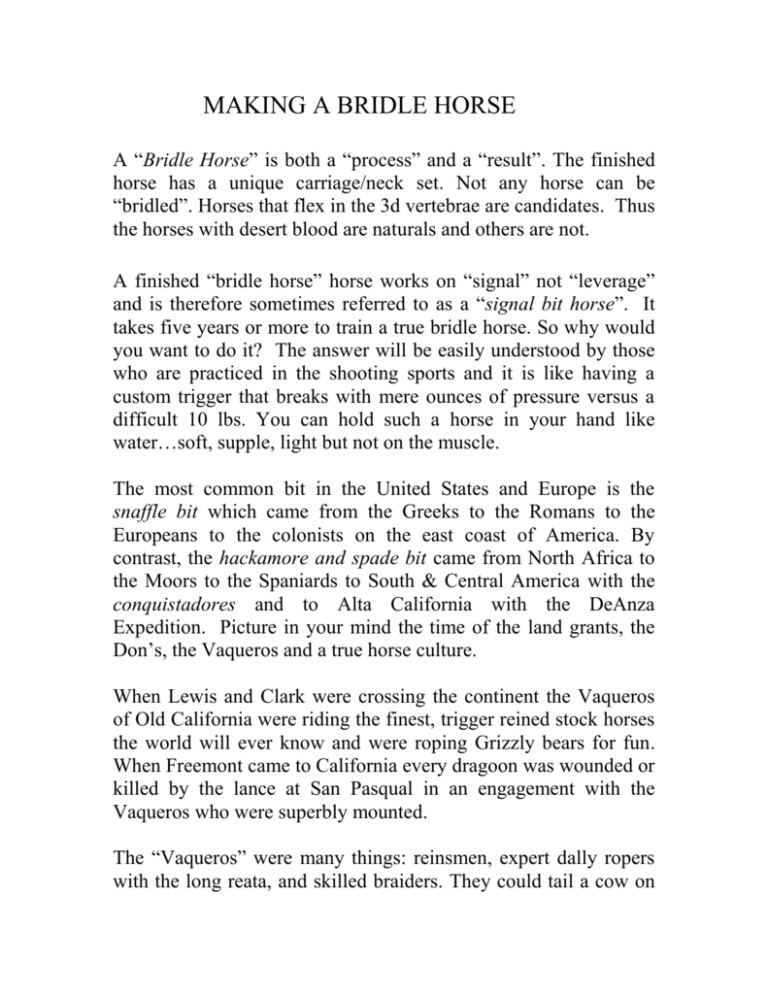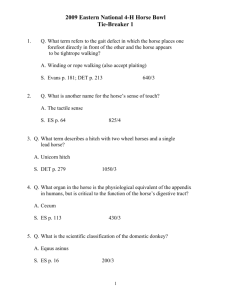
MAKING A BRIDLE HORSE
A “Bridle Horse” is both a “process” and a “result”. The finished
horse has a unique carriage/neck set. Not any horse can be
“bridled”. Horses that flex in the 3d vertebrae are candidates. Thus
the horses with desert blood are naturals and others are not.
A finished “bridle horse” horse works on “signal” not “leverage”
and is therefore sometimes referred to as a “signal bit horse”. It
takes five years or more to train a true bridle horse. So why would
you want to do it? The answer will be easily understood by those
who are practiced in the shooting sports and it is like having a
custom trigger that breaks with mere ounces of pressure versus a
difficult 10 lbs. You can hold such a horse in your hand like
water…soft, supple, light but not on the muscle.
The most common bit in the United States and Europe is the
snaffle bit which came from the Greeks to the Romans to the
Europeans to the colonists on the east coast of America. By
contrast, the hackamore and spade bit came from North Africa to
the Moors to the Spaniards to South & Central America with the
conquistadores and to Alta California with the DeAnza
Expedition. Picture in your mind the time of the land grants, the
Don’s, the Vaqueros and a true horse culture.
When Lewis and Clark were crossing the continent the Vaqueros
of Old California were riding the finest, trigger reined stock horses
the world will ever know and were roping Grizzly bears for fun.
When Freemont came to California every dragoon was wounded or
killed by the lance at San Pasqual in an engagement with the
Vaqueros who were superbly mounted.
The “Vaqueros” were many things: reinsmen, expert dally ropers
with the long reata, and skilled braiders. They could tail a cow on
the run, fight bulls with the lance from horseback, and would bet
their horses on how far they could slide them. They did not know
what a snaffle bit was.
They had a unique horse
language……“Amansador” (the horse breaker), “Reinador”(the
one who makes fine reined horses), “Dar La Vuelta” (translates “to
take your dallys on the horn), “Testarazo” (a body blow with the
horse), and “Capriole” (the movement in warfare where the horse
leaps in the air and kicks out with both hind feet to rid his rider of
attackers on foot).
It is said these old timers “never tightened a rein”. They rode a
long time in the hackamore. They did not put a bit in the horse’s
mouth until he had his bridle teeth after he was 5 years old. Only
one man rode each horse. Thus the horse and rider had an affinity
for each other. The horse could almost read the man’s mind. They
used double reins, their legs, their voices anything but pull on the
horse’s mouth.
The culture spread throughout the Great Basin of the U.S.
“Vaquero” (properly pronounced as “Buc-Ker-O) became “BuckA-Roo”. The flat hats, armitas, the long reata w/ 20ft loop, dally
roping vs “hard and fast” and pride in how soft you could rope and
lay a cow down to be doctored all this came from the Vaqueros.
But most importantly they spread the use of the “Jaquima” or
“Hackamore”, the two rein and the “Spade” Bit. This unique
culture and tradition survived into the 1950s when these men who
had the complete skill set began to die out. But Ed Connell wrote
“Hackamore Reinsman” and “Reinsmen of the West” and Arnold
Rojas wrote “Last of the Vaqueros” and Luis Ortega wrote
“California Stock Horse”.
And the tradition hung on in California, Nevada and Oregon into
the 1960s with such men as Tony Amaral and Dick Deller (One
Man’s Opinion About Spade Bits). Through the advent of the
National Reined Cow Horse Association, the hackamore gained
ground with gifted trainers like Bobby Ingersoll and today there is
a renaissance with men and women who can bridle a horse such as
Ray Ordway, Mike Bridges, Buck Branaman, Pat Puckett, Martin
Black, Richard Caldwell, Shelia Varian and more who now
demonstrate their skill in that unique competition, The
“Californios”. And there are some books recently published to
include Vaquero Horsemanship published by Ed Connell’s
daughter Leslie, in Texas that features many articles on
horsemanship by Ed that were published in magazines in the
1950s-1960s and those priceless letters exchanged between Ed and
Al Grandchamp.
The old way was hackamore, to the two rein, to the bridle. The
purpose of the hackamore is to “make” the horse before the bit is
ever introduced into the picture. The whole system is to take the
horse to “lighter and lighter” signals…..so several changes of
mecates (the horse hair reins used with the hackamore made from
mane hair twisted in strands) by weight are made with each of the
different size hackamores and bosals. When the bit is finally
introduced, it is perhaps a “Mac Mouth Piece”, a “Mona Lisa” or a
“San Joaquin”, working up to a true “Spade”….and the reins are
never “pulled”.
This process takes several good hackamores of decreasing size
(3/4, 5/8, ½, 3/8, ¼) and weight. A Hackamore is all rawhide
braided with a core, a nose button, bars, and a heel knot and they
are described by size, length, plait count, and bevel of the strings.
It may have a fiador (a special throat latch), and it will have the
mecate reins and the whole set up is called a hackamore. The
braided nose band alone is called a hackamore as well but when it
is 3/8 and below in diameter it is a “bosal” not a hackamore.
The mecate balances the hackamore and thus it must be no larger
in diameter than the diameter of the bars of the hackamore. A
hackamore works opposite from a snaffle. Instead of being
“pulled” by the corner of his mouth the horse is learning to move
away from the pressure of a signal on his nose and on his jaws
generated by nose button rotation and by bar signal. The principle
is Signal and Release or rein/release. Q. Which hackamore is right
for my horse?? Mike Bridges wants medium stiff lay in his bosals
and Shelia Varian wants them as soft as possible. And Al
Grandchamp with over 100 years of experience says: “It depends
on the horse” (and the personal preference of the horseman).
You can train with just one good quality 5/8’s hackamore or with
ten of every conceivable size (you can play golf with nothing but a
#2 iron but you won’t play well). The main point is that until the
horse is performing at top level in that size you DO NOT
CHANGE. And if you start a horse in a snaffle (that’s the new
way) you might go back and forth from hackamore to snaffle. And
you might two rein with the snaffle and the hackamore. The
sequence of hackamores is 3/4 to 5/8 to 1/2 and when the horse is
solid in the 1/2 then you introduce the bit and a 3/8 bosal and the
two rein.
Bits are a whole different topic. Let’s look at a true Spade. I
won’t try to describe it as Dick Dellums has already done that very
well. But I will add that Arnold Rojas wrote that “from the bar to
the top of the port must be at least 3 ¼”.” The port must be at an
angle so that it will signal the horse just as the curb tightens….use
only a leather curb with the spade NEVER A CHAIN. Horses
have different size mouths, different tongue thicknesses.We want
the effect of the bit to be in proportion to the sensitivity of the
mouth of that particular horse. We want no wrinkle in the horse’s
mouth and two fingers between the curb and the chin groove. We
want the horse to “pack” the bit (pick it up with his mouth and
‘carry it”. The secret of the spade is that the horse never learns to
lean on or brace on the bit and thus never has a hard mouth. When
the bit is first introduced we’ll leave off the romal (the braided
reins) and just guide with the mecate and the 3/8 bosal. Then we’ll
add the Romal with the Mecate in front and the Romal behind.
We’ll eventually introduce Romal signals and finally place the
Romal in front and the mecate behind it and signal primarily with
the Romal. Finally, the mecate is removed and the horse is
“Straight Up in the Bridle” but he wears a small “Bosalilo” to
“honor the horse” and a get down rope to lead him.
This has been a broad overview to a very deep subject and the old
adage to “drink deeply or not at all” applies. If you are interested
seek out one of the men I named and become an understudy.
Copyright John M. Hutcheson, 539 Gab Creek Farm Road,
Dahlonega, GA, 706-864-3690. ALL RIGHTS RESERVED.








